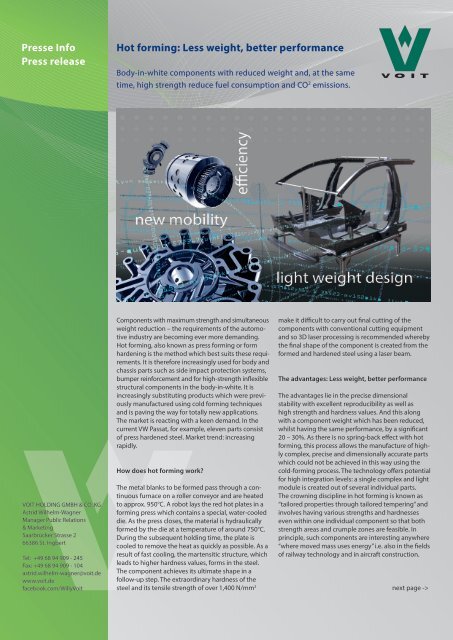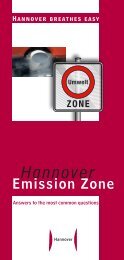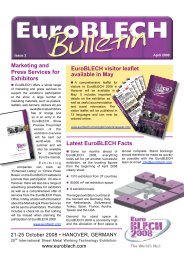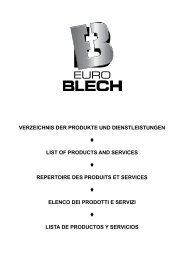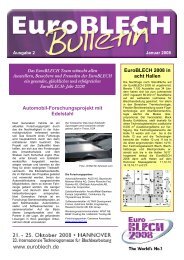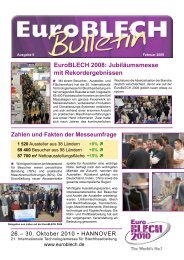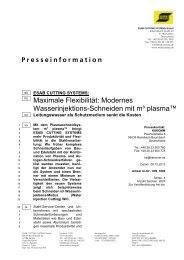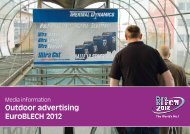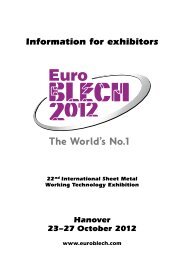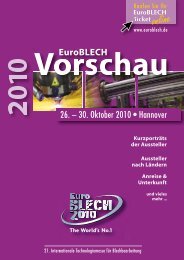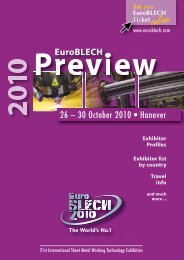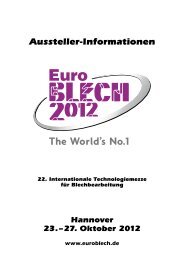Presse Info Press release Hot forming: Less weight, better ...
Presse Info Press release Hot forming: Less weight, better ...
Presse Info Press release Hot forming: Less weight, better ...
Create successful ePaper yourself
Turn your PDF publications into a flip-book with our unique Google optimized e-Paper software.
<strong><strong>Press</strong>e</strong> <strong>Info</strong><br />
<strong>Press</strong> <strong>release</strong><br />
VOIT HOLDING GMBH & CO. KG<br />
Astrid Wilhelm-Wagner<br />
Manager Public Relations<br />
& Marketing<br />
Saarbrücker Strasse 2<br />
66386 St. Ingbert<br />
Tel: +49 68 94 909 - 245<br />
Fax: +49 68 94 909 - 104<br />
astrid.wilhelm-wagner@voit.de<br />
www.voit.de<br />
facebook.com/WillyVoit<br />
<strong>Hot</strong> <strong>forming</strong>: <strong>Less</strong> <strong>weight</strong>, <strong>better</strong> performance<br />
Body-in-white components with reduced <strong>weight</strong> and, at the same<br />
time, high strength reduce fuel consumption and CO 2 emissions.<br />
Components with maximum strength and simultaneous<br />
<strong>weight</strong> reduction – the requirements of the automotive<br />
industry are becoming ever more demanding.<br />
<strong>Hot</strong> <strong>forming</strong>, also known as press <strong>forming</strong> or form<br />
hardening is the method which best suits these requirements.<br />
It is therefore increasingly used for body and<br />
chassis parts such as side impact protection systems,<br />
bumper reinforcement and for high-strength inflexible<br />
structural components in the body-in-white. It is<br />
increasingly substituting products which were previously<br />
manufactured using cold <strong>forming</strong> techniques<br />
and is paving the way for totally new applications.<br />
The market is reacting with a keen demand. In the<br />
current VW Passat, for example, eleven parts consist<br />
of press hardened steel. Market trend: increasing<br />
rapidly.<br />
How does hot <strong>forming</strong> work?<br />
The metal blanks to be formed pass through a continuous<br />
furnace on a roller conveyor and are heated<br />
to approx. 950°C. A robot lays the red hot plates in a<br />
<strong>forming</strong> press which contains a special, water-cooled<br />
die. As the press closes, the material is hydraulically<br />
formed by the die at a temperature of around 750°C.<br />
During the subsequent holding time, the plate is<br />
cooled to remove the heat as quickly as possible. As a<br />
result of fast cooling, the martensitic structure, which<br />
leads to higher hardness values, forms in the steel.<br />
The component achieves its ultimate shape in a<br />
follow-up step. The extraordinary hardness of the<br />
steel and its tensile strength of over 1,400 N/mm 2<br />
make it difficult to carry out final cutting of the<br />
components with conventional cutting equipment<br />
and so 3D laser processing is recommended whereby<br />
the final shape of the component is created from the<br />
formed and hardened steel using a laser beam.<br />
The advantages: <strong>Less</strong> <strong>weight</strong>, <strong>better</strong> performance<br />
The advantages lie in the precise dimensional<br />
stability with excellent reproducibility as well as<br />
high strength and hardness values. And this along<br />
with a component <strong>weight</strong> which has been reduced,<br />
whilst having the same performance, by a significant<br />
20 – 30%. As there is no spring-back effect with hot<br />
<strong>forming</strong>, this process allows the manufacture of highly<br />
complex, precise and dimensionally accurate parts<br />
which could not be achieved in this way using the<br />
cold-<strong>forming</strong> process. The technology offers potential<br />
for high integration levels: a single complex and light<br />
module is created out of several individual parts.<br />
The crowning discipline in hot <strong>forming</strong> is known as<br />
“tailored properties through tailored tempering” and<br />
involves having various strengths and hardnesses<br />
even within one individual component so that both<br />
strength areas and crumple zones are feasible. In<br />
principle, such components are interesting anywhere<br />
“where moved mass uses energy” i.e. also in the fields<br />
of railway technology and in aircraft construction.<br />
next page ->
<strong><strong>Press</strong>e</strong> <strong>Info</strong><br />
<strong>Press</strong> <strong>release</strong><br />
VOIT HOLDING GMBH & CO. KG<br />
Astrid Wilhelm-Wagner<br />
Manager Public Relations<br />
& Marketing<br />
Saarbrücker Strasse 2<br />
66386 St. Ingbert<br />
Tel: +49 68 94 909 - 245<br />
Fax: +49 68 94 909 - 104<br />
astrid.wilhelm-wagner@voit.de<br />
www.voit.de<br />
facebook.com/WillyVoit<br />
Not many companies can master this technology and<br />
capacities on the international market are correspondingly<br />
in short supply. A new supplier within this<br />
market is VOIT TPH – Technology for <strong>Press</strong> Hardening,<br />
a spin-off of WILLY VOIT GmbH & Co. KG., which was<br />
founded in 1947 (www.voit.de). The automotive<br />
supplier with global operations has a workforce of<br />
approximately 1,000 employees at its headquarters<br />
in St. Ingbert (Germany) and over 1,600 employees<br />
worldwide at six production locations in Germany,<br />
France, Poland and Mexico. The portfolio is made up<br />
of three business units – aluminum high-pressure diecasting,<br />
cold-<strong>forming</strong> and hot-<strong>forming</strong> technology.<br />
High-precision, high-pressure die-cast parts are developed<br />
and produced according to customer specifications<br />
with finally- processed and finished functional<br />
surfaces as well as finished castings and components<br />
using punching, drawing and roll-bending technology<br />
and innovative light-<strong>weight</strong> components<br />
using hot-<strong>forming</strong> technology. The range includes<br />
complete solutions from engineering through toolmaking,<br />
the foundry, punching shop and finishing<br />
department to logistics. Over 170 million parts are<br />
fitted in the world’s most popular cars such as Audi,<br />
BMW, Ford, Jaguar, Landrover, Mercedes, Opel, VW,<br />
Porsche.... VOIT expertise and products are in high<br />
demand on the market and are installed in more than<br />
50% of cars. The company is also committed to the<br />
fields of greentech and electro mobility.<br />
In the field of hot-<strong>forming</strong>, VOIT is focusing on large<br />
scale production. The first facility may soon be<br />
followed by others. A capacity of up to three million<br />
passes is to be available within the next three years.<br />
Depending on growth forecasts, a total of six facilities<br />
are planned for the next few years. It would then<br />
be possible to produce between six and ten million<br />
parts a year. The new hot-<strong>forming</strong> technology at<br />
VOIT is a courageous step in the right direction as it<br />
meets the OEM’s need for light and simultaneously<br />
high-strength car body parts which therefore offer<br />
a high degree of safety. As a result of the significant<br />
reduction in the vehicle <strong>weight</strong>, they are ultimately<br />
able to offer their customers concrete advantages<br />
with regard to lower fuel consumption and reduced<br />
CO 2 emissions.


